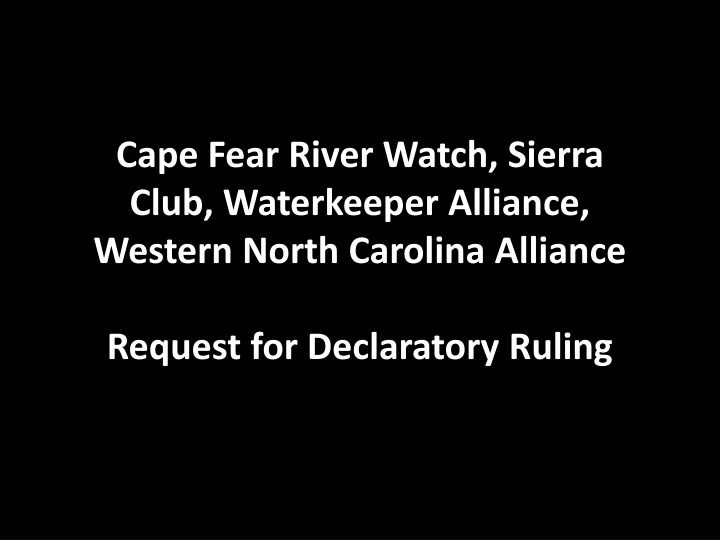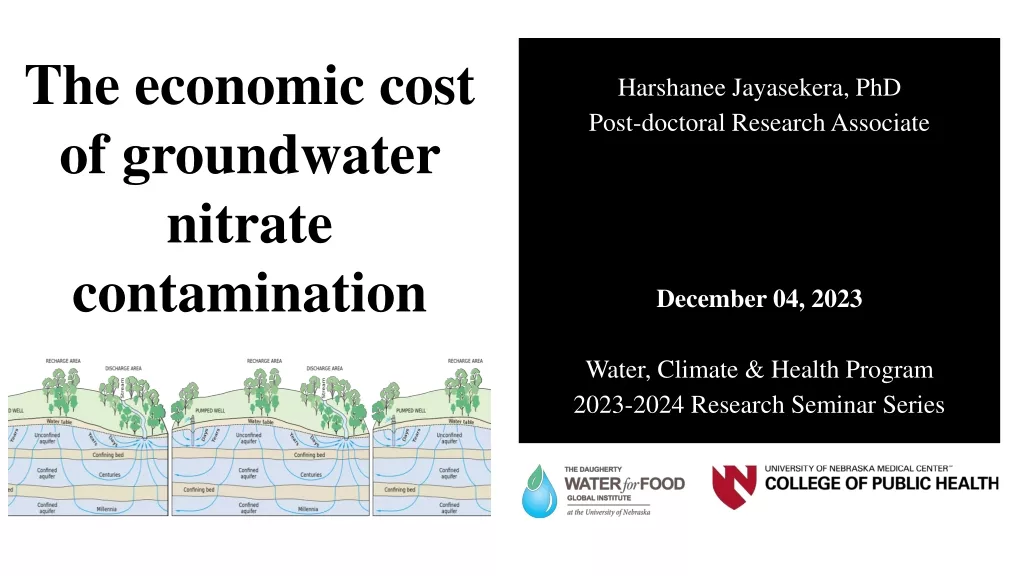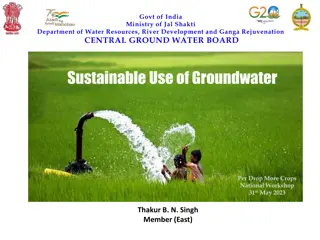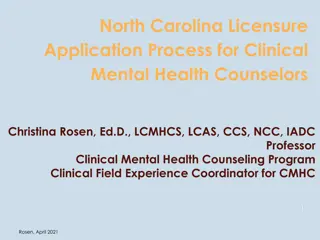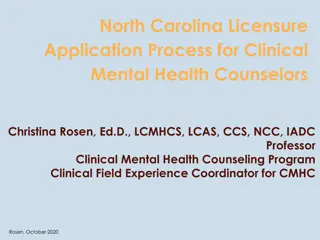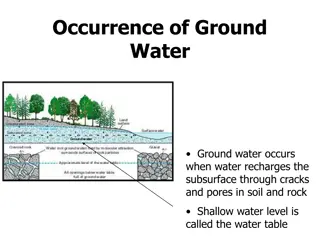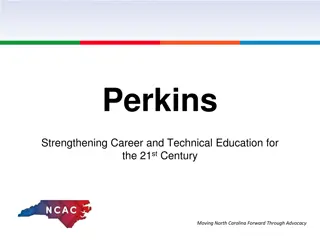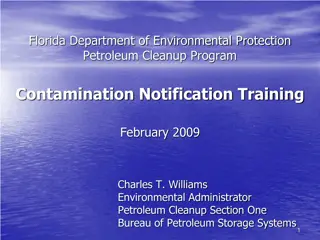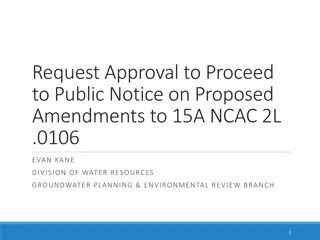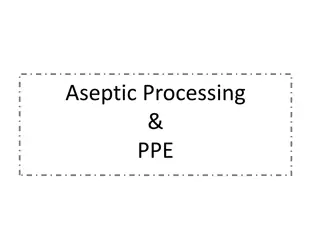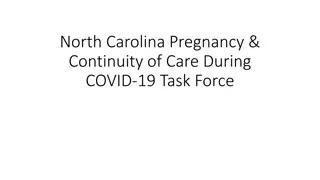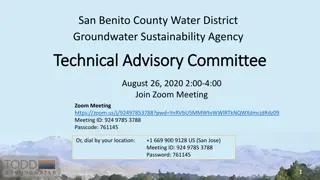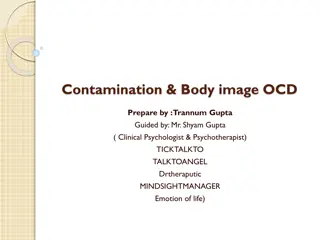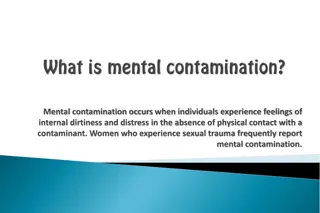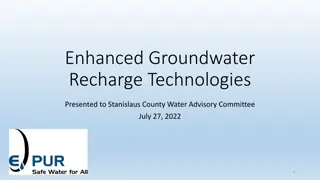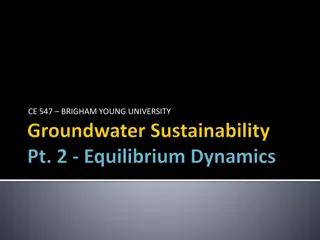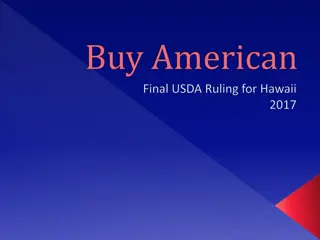Request for Declaratory Ruling Regarding Groundwater Contamination in North Carolina
Cape Fear River Watch, Sierra Club, Waterkeeper Alliance, and Western North Carolina Alliance have petitioned the EMC for a declaratory ruling concerning the application of groundwater rules to coal ash lagoons. They seek clarification on the 2L Rule's requirements for corrective action and source elimination, pointing out a genuine controversy regarding existing interpretations and enforcement by DENR across various contaminated sites in the state.
Download Presentation

Please find below an Image/Link to download the presentation.
The content on the website is provided AS IS for your information and personal use only. It may not be sold, licensed, or shared on other websites without obtaining consent from the author.If you encounter any issues during the download, it is possible that the publisher has removed the file from their server.
You are allowed to download the files provided on this website for personal or commercial use, subject to the condition that they are used lawfully. All files are the property of their respective owners.
The content on the website is provided AS IS for your information and personal use only. It may not be sold, licensed, or shared on other websites without obtaining consent from the author.
E N D
Presentation Transcript
Cape Fear River Watch, Sierra Club, Waterkeeper Alliance, Western North Carolina Alliance Request for Declaratory Ruling
Nature of the Request On request of a person aggrieved, an agency shall issue a declaratory ruling . . . as to the applicability to a given state of facts . . . of a rule . . . . N.C. Gen. Stat. 150B-4(a) Petitioners ask EMC to apply its groundwater Rule to a given state of facts: A coal ash lagoon, whether closed or currently operating, that was originally issued an NPDES permit prior to December 30, 1983, and has contaminated groundwater in excess of standards inside its compliance boundary. See Joint Factual Stipulation Such a facility must, under the 2L Rule: Implement corrective action when it contaminates groundwater anywhere in excess of standards, whether or not contamination has crossed a compliance boundary; Take immediate action to eliminate sources of contamination, in advance of a plan for restoring contaminated groundwater; and Meet these same requirements even after they are closed.
No Exceptions Apply Petitioners request a clarification of the 2L Rule as plainly written, not a change to the rule. The General Assembly recently revoked statutory authority to decline a request as undesirable for good cause. Even so, the EMC s good cause exceptions do not apply (15A NCAC 2I.0603): No previous contested case or hearing; Not the subject of a pending contested case or litigation; Factual context not specifically considered when the 2L Rule was adopted; and A genuine controversy.
A Genuine Controversy In 2009, DENR asked the AG: For ash ponds permitted prior to Dec. 30, 1983, . . . where must standards be met . . . [a]t the compliance boundary, or under the entire site? The AG stated: [S]tandards must be met at the compliance boundary. DENR also asked for guidance on immediate action required [t]o eliminate the source or sources of contamination. The AG response conflated eliminating sources of contamination with the separate process for restoring contaminated groundwater. DENR has proposed regulating closed coal ash ponds under DWM permits and enforcing standards only at the compliance boundary.
A Genuine Controversy DENR has applied these interpretations state wide. Asheville Thallium and other contaminants exceeding standards inside the compliance boundary Sutton Arsenic and other contaminants exceeding standards inside the compliance boundary 12 other plants contaminants exceeding standards inside the compliance boundary DENR has not required any plant to: (1) implement corrective action for contamination inside a compliance boundary, or (2) take immediate action to eliminate a source of such contamination. Progress and Duke propose to close coal plants and coal ash lagoons
Petitioners are Persons Aggrieved [A]ny person or group of persons of common interest directly or indirectly affected substantially in his or its person, property, or employment by an administrative decision N.C. Gen. Stat. 150B-2(6) Four nonprofit organizations with missions to protect surface and ground waters from contamination. Members live near contaminated groundwater and recreate and work in rivers and lakes threatened by the contamination. Twelve Sworn statements submitted by Petitioners: Eleven staff and members of Petitioners who work to remedy coal ash contamination and who recreate and work in affected waters. Including three members who earn their living from businesses on rivers threatened by groundwater contaminated by coal ash An expert witness confirming that Asheville plant contamination is distinct from background levels and intermixes with the River
The Merits Active coal ash lagoons have NPDES permits. Coal ash lagoons with NPDES permits have compliance boundaries. All facilities with permit-defined compliance boundaries are exempt from civil penalties (but not other enforcement) for contamination within a compliance boundary and carry an RS designation. Subsection .0106(d) requires corrective action from facilities under authority of a permit for exceedences of standards at or beyond a compliance boundary. Subsection .0106(c) governs corrective action for a facility that has not been permitted and requires corrective action without any reference to a compliance boundary. Facilities without permits do not have compliance boundaries. Subsection .0106(e) states that facilities with permits first issued prior to December 30, 1983 are deemed not permitted and subject to the provisions of subsection .0106(c). Subsection .0106(c) requires unpermitted facilities to take immediate action to eliminate the source or sources of contamination separate from a corrective action plan.
